The UiPath StudioX interface contains multiple panels for easy access to specific functionalities. Panels can be docked, set to float so that they can be moved anywhere, or they can be set to auto-hide.
Backstage View
This is the view you see when you first open StudioX. You can also get here by clicking Home in the upper-left corner of the Design View. You can access your projects, configure StudioX settings, or access help and license information. The following buttons and tabs are available in this view:
- Open - Browse to an automation project and open it.
- Close - Close the automation project that is currently open.
- Start - Create a new task automation project or open recently accessed projects.
- Tools - Install the Excel Add-in and extensions for web browsers and other applications that allow StudioX to capture actions you perform in them. For more information on extensions, see About Extensions.
- Settings - Change the look and feel of StudioX, set global preferences, and manage activities -packages sources. For more information, see Configuring StudioX Settings.
- Help - Directs you to product documentation, release notes, online resources, the Community Forum and the RPA Academy.
Information regarding product version and installation, license availability, update channel and device ID is also found in the Help tab, together with a Copy Info button for quickly copying the details to the clipboard.

Design View
This is the view where you create, execute, and publish your automation, and manage the Excel workspace and activities packages for the project.
The Ribbon
The ribbon at the top of the window can be minimized or expanded by clicking the Minimize / Expand button  . It contains the following buttons:
. It contains the following buttons:
- Save - Saves the automation project.
- Run - Executes the automation project.
- Cut / Copy / Paste - Use these buttons to cut, copy, or paste activities on the Designer panel.
- Open Excel Workspace - Opens the Excel file you defined as the Excel Workspace for the automation project. To edit the settings of the workspace, click the arrow next to this button and then select Configure Excel Workspace.
- Manage Packages - Opens the Manage Packages window where you can configure the activities packages and sources for the project.
- Data Extraction - Opens the Extract wizard that enables you to extract structured data from an application or a web page. For more information, see Extract Data.
- Validate File - Checks for validation errors in the project and outputs the result to the Error List panel.
- Export to Excel - Exports the automation project to an Excel file.
- Publish - Archives the project and all the other files in the project folder so that it can be sent to Robots and then executed.
- Project - Select Project Settings to edit properties such as the name and the description of the project, or Open Project Folder to open the project folder in the Windows file explorer.
Note:
Files that are not created during the execution of the automation project become read-only when published to Orchestrator. If your business process requires you to write in a specific file at some point, be sure to create it while designing the project.
Add Activity Search Bar
In the Add Activities search bar you can quickly search through activities and add them to the automation project.
You can open the Add activity search bar by clicking the  icon at the top or bottom of any activity added to your project. or by using the Ctrl + Shift + T keyboard shortcut.
icon at the top or bottom of any activity added to your project. or by using the Ctrl + Shift + T keyboard shortcut.
The bar is split into two sections:
- Common Scenarios contains predefined scenarios for common processes and suggestions of activities you may want to add next based on the activities you have already added and on where in the project workflow you click
 .
. - Activities lists all the activities in the installed packages.
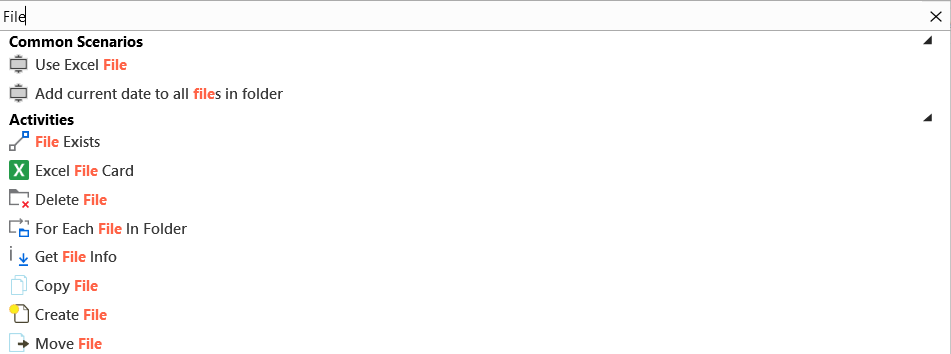
Send Feedback
There are two types of feedback that you can send directly from within StudioX: Submit an idea or Report a bug. Both are accessible by clicking  on the title bar.
on the title bar.
In the User Voice window, provide the following information and then click Send:
- From the What drop-down menu, select either Improvement or Bug.
- From the File on drop-down menu, select the product for which to send feedback.
- In the Title field, enter a title for the improvement or bug.
- In the Steps to Reproduce field, enter a detailed description.
- Click Add to attach files. You can attach up to 6 images, videos, or text files, each with a size smaller than 10MB.
Please note that you cannot send more than 3 posts in a time frame of 5 minutes.
Note:
The Activities panel and the Add Activity search bar support fuzzy search, which means that a list of results is returned even if the search terms don't match exactly. The search terms could be slightly incomplete, misspelled or include only the first letter of each word.
The Designer Panel
The Designer panel is the canvas on which you create your automation. This is where you add the activities you want to automate, view and edit their properties, and define the workflow by ordering activities. Your automation process is represented by a diagram that gives you a visual representation of the sequence of activities it contains.
You can add activities from the Activities panel by double-clicking or dragging and dropping them, or by clicking the  button above and below an already added activity and then selecting them from the Add Activity search bar. For every activity added to the panel you can see details such as the display name, key activity properties, buttons and links that help you configure it, or an informative screenshot. To help you identify different types of activities, the left border of each activity has the color of the application it applies to. For example, Excel activities have a green left border, while Outlook activities have a blue left border.
button above and below an already added activity and then selecting them from the Add Activity search bar. For every activity added to the panel you can see details such as the display name, key activity properties, buttons and links that help you configure it, or an informative screenshot. To help you identify different types of activities, the left border of each activity has the color of the application it applies to. For example, Excel activities have a green left border, while Outlook activities have a blue left border.
You can navigate within a diagram by double-clicking the activity you want to view. The path is displayed as breadcrumbs in the header of the Designer panel. Please note that when using multiple displays that are scaled differently, text that appears in some activities might not be displayed correctly.

Activate Pan Mode by clicking the  icon, holding the Space key or pressing the middle mouse button. Use the zoom drop-down to change the zoom level and click the
icon, holding the Space key or pressing the middle mouse button. Use the zoom drop-down to change the zoom level and click the  icon to reset it back to 100%.
icon to reset it back to 100%.
The Fit to Screen  icon changes the zoom in such a way that the whole workflow fits in the Designer panel. Click the
icon changes the zoom in such a way that the whole workflow fits in the Designer panel. Click the  icon to get an overview of the whole project and navigate through sections by adjusting the focus.
icon to get an overview of the whole project and navigate through sections by adjusting the focus.
The Context Menu
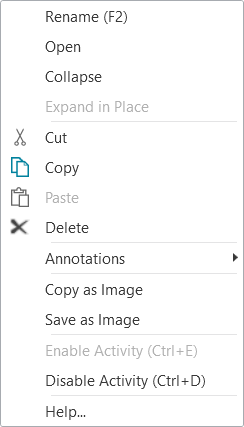
The context menu enables you to perform several operations on the activities in your project. You can display it by right-clicking any activity inside your project.
Note
If you select more activities, the menu is not displayed at all.
Field Descriptions for the Context Menu
| Option | Description |
|---|---|
| Rename | Edit the name of the activity. |
| Open | Opens the selected activity in the Designer panel. Has the same result as double-click. |
| Collapse | Collapses the activity thus reducing the displayed details to "Double-click to view". You can achieve the same result by clicking the Collapse button  . . |
| Expand in Place | Expands the content of the activity, displaying its detailed content. You can achieve the same result by clicking the Expand button  . . |
| Cut | Removes the selected activity and places it onto the Clipboard. |
| Copy | Copies the selected activity and places it onto the Clipboard. |
| Paste | Inserts the content of the Clipboard at the current location. |
| Delete | Deletes the target activity. Note: Since the Context menu is only displayed for a one-activity selection, you can use this command for more activities with the corresponding keyboard shortcut, Delete. |
| Annotations | Add, edit, delete, show and hide annotations added to activities in the workflow. |
| Copy as Image | Makes a screenshot of the content displayed in the Designer panel. Note: If you want to make a screenshot of a child activity, make sure to firstly open it in the Designer panel. |
| Save as Image | Makes a screenshot of the content displayed in the Designer panel and prompts the user to set the details for saving it (Name, Type, Destination). Supported formats: JPG, PNG, GIF, XPS. |
| Enable Activity | Enables a previously disabled activity. |
| Disable Activity | Disables an activity, which is then placed inside a Comment out activity. |
| Help | Opens the help page about the activity type in the Activities guide. |
The Activities Panel
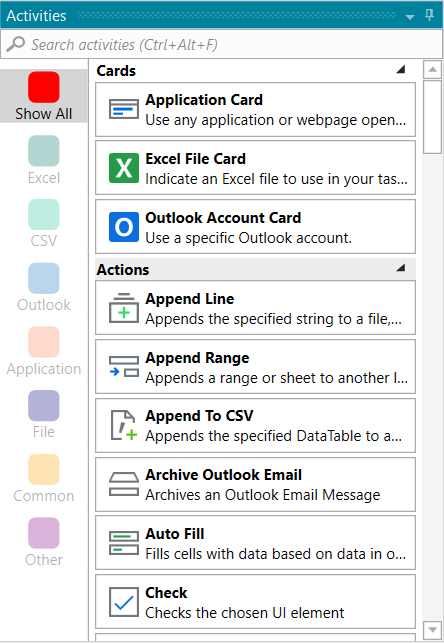
The Activities panel shows available activities that can be added to the current project. The name, icon, and a short description are displayed for each activity. To add an activity to your automation, double-click it or drag and drop it to the desired place in the Designer panel.
You can search for activities using the search box at the top of the panel or filter them by type using the tabs on the left of the panel. The following tabs are available: Show All (the default selection), Excel, CSV, Outlook, System, Automation, and Common.
Note:
The search box can be used for finding activities by their class name, regardless of the interface language set in StudioX.
The Data Manager Panel
The Data Manager panel displays data currently added to your automation project. This data includes:
- Excel Workspace.
- The output values that you saved for later use in the project. You can rename a saved value by right-clicking it and selecting Rename Saved Value. To go to the activity where a saved value was defined, double-click the saved value.
- The cards added to the project. To bring a card into focus on the Designer panel, double-click it.
The Properties Panel
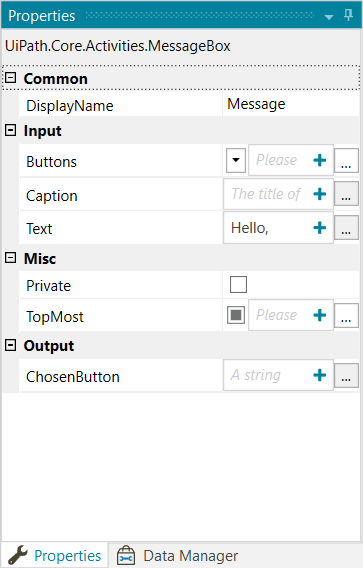
The Properties panel is contextual and enables you to view and edit the properties of a selected activity. When selecting multiple activities the same workflow, only their common properties can be modified from the Properties panel.
The way you configure each property depends on the nature of the property field. Some fields are configured using a text box, check box, or drop-down menu, while for others you can select data from  menu.
menu.
The Output Panel
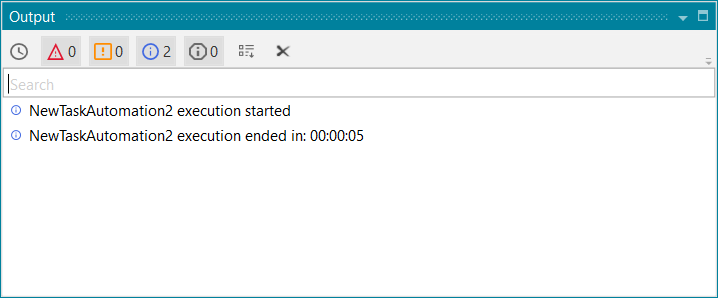
The Output panel enables you to display the output of the Write Line activity, displays status information regarding the execution of your projects, and errors generated by activities packages.
From the Output panel, you can show or hide messages that have different log levels (errors, warnings), or export the contents of the panel to a text file by clicking the buttons in the panel’s header. Double-clicking a message displays further details about it, with the option to copy information.
The Clear All button erases all info displayed in the Output panel. Logs and other data stored in this panel are erased when a workflow is run. The Output panel displays up to 2,000 lines at a time.
Updated 3 years ago